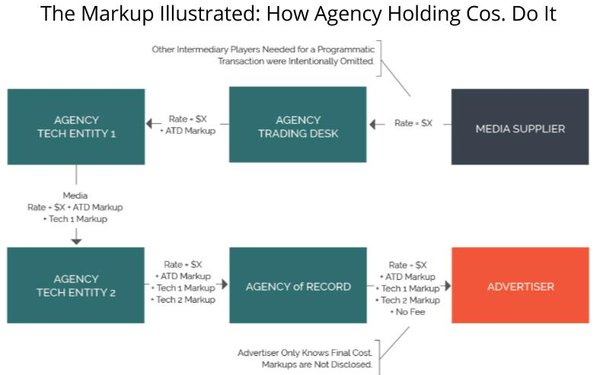ANA Finds Agency Media Kickbacks 'Pervasive,' High-Level Execs Signed Off
- by Joe Mandese @mp_joemandese, June 7, 2016

The Association of National Advertisers this morning released findings of an extensive probe into the “transparency,” or lack thereof, of agency media-buying practices and said it found the practice of kickbacks or non-transparent media rebates to agencies to be “pervasive.”
The findings, which are the result of an eight-month study conducted by K2 Intelligence, found “evidence of a fundamental disconnect in the advertising industry regarding the basic nature of the advertiser-agency relationship” and called for full “disclosure” of the media-buying process.
“Specifically, the study revealed that senior executives across the agency ecosystem were aware of, and mandated, some non-transparent business practices,” the ANA said in a statement released this morning, adding: “Contracts for rebates and other non-transparent business practices were negotiated and sometimes signed by high-level agency executives.”
advertisement
advertisement
Even worse, the ANA study implied evidence of potentially criminal activities. While it did not utilize that language specifically, it said the findings revealed “potentially problematic agency conduct concealed by principal transactions; as a principal, an agency (or its holding company or associated company) purchases media on its own behalf and later resells it to a client after a markup.”
The ANA was set to brief the industry later this morning, but the key findings indicate that non-transparent business practices employed by agencies, some of which may or may not have been contract-compliant, included the following:
*Cash rebates from media companies were provided to agencies with payments based on the amount spent on media. Advertisers interviewed in the K2 Intelligence study indicated they did not receive rebates or were unaware of any rebates being returned.
*Rebates in the form of free media inventory credits.
*Rebates structured as “service agreements” in which media suppliers paid agencies for non-media services such as low-value research or consulting initiatives that were often tied to the volume of agency spend. Sources told K2 Intelligence that these services “were being used to obscure what was essentially a rebate.”
*Markups on media sold through principal transactions ranged from approximately 30 percent to 90 percent, and media buyers were sometimes pressured or incentivized by their agency holding companies to direct client spend to this media, regardless of whether such purchases were in the clients’ best interests.
*Dual rate cards in which agencies and holding companies negotiated separate rates with media suppliers when acting as principals and as agents.
*Non-transparent business practices in the U.S. market resulting from agencies holding equity stakes in media suppliers.
*The study revealed that non-transparent business practices were found across digital, print, out-of-home, and television media. In addition, the non-transparent practices were found to exist across the spectrum of agency media entities.
The ANA said the report detailed “source accounts from dozens of confidential, personal interviews as well as documentary evidence.”




If this is the degree of specificity included in this much awaited report, how are the agencies supposed to respond? It would be, at a minimum, helpful if such distinctions were isolated by medium---especially digital versus TV. It would also have been helpful if some estimate of the amount of ad spending affected was at least estimated. As for the evidence of "criminal" asctivity, if this so----and it may well be----shouldn't such evidence be turned over tp the appropriate authorities? Or is this merely a device to put pressure on all ad agencies and tar them with a single brush?
@Ed Papazian: These are just the top-lines, the report is still being disclosed via a Q&A briefing (now), but ANA chief Bob Liodice said the goal of this study was not to probe criminal activity, just to find facts on the pervasiveness of non-transparent practices. More to come.
Thanks for that clarification, Joe. I hope that the full report provides the substance that this important issue deserves.
The diagram in this post appears to cover the digital process flow, revolving around the agency trading desk - the "arbitrage" price spread between purchase and resale. We've known about this since online ad "trading" kicked off around 2008. There were even panel sessions hosted and attended by affetced parties at which the existence and impact of arbitrage was the prime topic. If the condition exists in the overall media buying landscape, and has existed on a large scale predating online exchanges and automated buying technology, where do we go from here? Are professional and personal relationships among agencies, slients and media owners damaged beyond repair?
Henry, it remains to be seen whether the "situation" we are all concerned existed prior to the last 5-8 years in traditional media and to what extent it now exists in national TV time buying. I hope that this investigation provides a clearer picture of what is or is not happening with some degree of specificity, not sweeping generalizations, many of which seem to deal with digital buys. Hopefully this will all become evident as the detailed findings are released.
Make that "concerned about". Sorry.
@Henry Blaufox: The flowchart is just one of several models delineated in the ANA report. This one illustrates an explicit markup process not disclosed to clients. It wasn't meant to be represenative of all of the study's conclusions. I recommend reviewing the report and if you feel moved, please add comments, observations or contribute otherwise: http://www.ana.net/content/show/id/industry-initiative-media-transparency-report